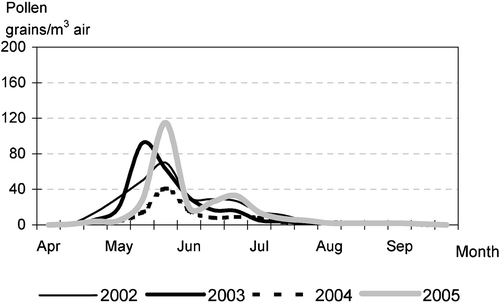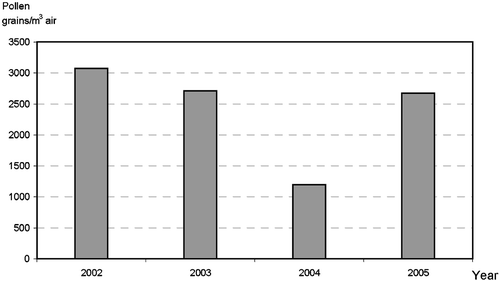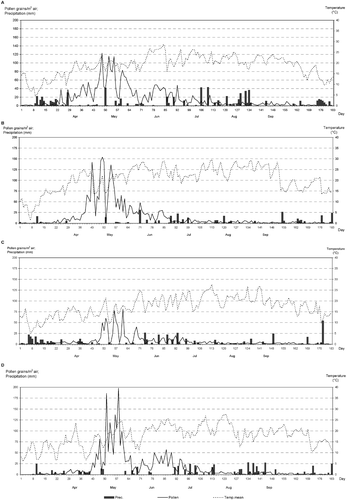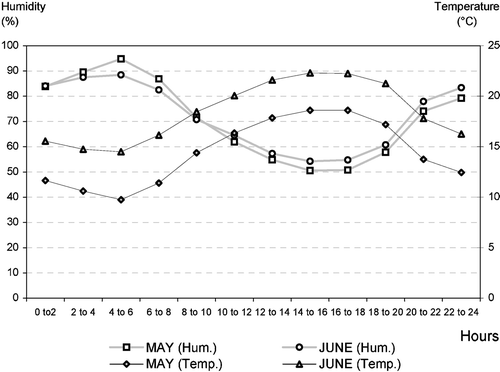Abstract
Pollen of grasses (Poaceae) is one of the most important airborne allergen sources worldwide. The aim of the study was to determine diurnal, day‐to‐day, weekly, monthly and annual pollen variation, and the effect of selected meteorological parameters on atmospheric pollen concentrations in Zagreb. A preliminary study was carried out during four seasons (2002 – 2005), using a 7‐day VPPS 2000 Hirst volumetric pollen trap. Total annual grass pollen concentrations in Zagreb were constant (2 673 – 3 074 p.g.m−3), with a relative drop in 2004 (1 196 p.g.m−3). The beginning of the grass pollen season is usually observed when the average daily temperature exceeds 13.5°C (max. daily temp. 19.5°C), without precipitation. In all four study years the absolute peak of concentrations occurs in the second half of May. The length of pollen season during the study period was 157 – 173 days. A high variability was observed in the maximal concentration and in the number of days when grass pollen concentration exceeded the threshold value of 30 p.g.m−3 (9 – 40 days). Statistically significant correlations were found between airborne grass pollen concentrations and air temperature, level of precipitation and relative humidity.
The botanical family of Poaceae (grasses) is one of the largest, comprising almost 700 genera and about 12 000 species. It is estimated that grasses account for about 20% of plant life on the planet (Mabberley, Citation1987). They are the basic food source for herbivorous animals (pastures are basically Poaceae) and also for humans (cereals, corn, rice, sugar cane). Grass pollen is one of the most important airborne allergen sources worldwide. About 20 species from five subfamilies are considered to be the most frequent causes of grass pollen allergy, and the allergenic relationships among them closely follows their phylogenetic relationships (Andersson & Lidholm, Citation2003). Twenty per cent of allergic patients in Denmark suffer from grass pollen allergies (Weeke & Spieksma, Citation1991). In Catalonia (north‐east Spain), Poaceae and Urticaceae (Parietaria) induce symptoms in 35% of patients and are thus the highest‐ranking taxa of allergenic significance (Belmonte & Roure, Citation1991; Belmonte et al. Citation1995). The degree of air pollution influences the threshold concentrations at which allergic symptoms to grass pollen are observed. Therefore it is important to monitor airborne pollen concentrations in city agglomerations. In recent years, a number of publications have highlighted differences or similarities that exist with pollen in the atmosphere at various locations (Green et al. Citation2004; Emberlin et al. Citation1994; Galan et al. Citation1995).
The first observations on (allergenic) pollen distribution in Croatia were carried out in 1959 at four locations: Zagreb, Hvar, Crikvenica and Dubrovnik. Using a gravimetric method, data were collected weekly throughout the year (Volarić‐Mršić, Citation1972). Modern aerobiological investigations using daily volumetric monitoring of atmospheric pollen began in Croatia in 2002 (Peternel et al. Citation2003, Citation2005).
The aim of this study was to compare the 2002 – 2005 pollen seasons, to determine diurnal, day‐to‐day, weekly and monthly pollen variation, and the effect of some meteorological parameters on atmospheric pollen concentrations in Zagreb. Here we present a report on airborne grass pollen presence.
Material and methods
The analysis of the atmospheric pollen presence was performed on the basis of data collected in Zagreb in the seasons of 2002 – 2005. A 7‐day VPPS 2000 Hirst volumetric pollen trap (Lanzoni, Bologna, Italy) was used for pollen sampling (Hirst, Citation1952; Raynor, Citation1979). The trap was placed on the roof of the NHMS Observatory – Grič which is 19.7 m high and is in the center of the City of Zagreb (45°49'N and 15°59'E; 157 m above the sea level). Zagreb is an urban area in the central part of Croatia with a population of approximately 1 000 000. The city is situated in a zone of a continental climate. For reading and processing the samples, the methods proposed by Dominguez et al. (Citation1991) were used and standardized for the entire Croatian Aerobiological Network. Pollen concentrations were expressed as pollen grain count m−3 air (p.g.m−3) and all the calculations were based on microscopic analysis of five longitudinal transects along the slide. The criterion for main pollen period was used according to Fernandez‐Gonzalez et al. Citation(1999), taking into account 95% of annual total pollen concentration, eliminating the initial and final 2.5%. The allergenicity scale we used in this study is currently used by the Catalonian Aerobiological Network (CAN; Belmonte et al. Citation2000). Following the CAN scale, a very high risk of allergenic exposure to grass pollen occurs when the mean weekly grass pollen concentration in the atmosphere exceeds 30 p.g.m−3 (scale rank of 4, very high). A week with a concentration of 20 – 29.9 p.g.m−3 is classified as high risk (rank 3), 5 – 19.9 p.g.m−3 medium risk (rank 2), 0.1 – 4.9 p.g.m−3 low risk (rank 1), and no risk when the rank and concentration are 0.
Meteorological data were obtained from the Croatian Meteorological and Hydrological Service (CMHS). In our study we used the daily average air temperatures, daily precipitation levels, and relative humidity. Temperature was measured three times a day (at 7.00 a.m., 2.00 p.m. and 9.00 p.m., local time), and values were averaged as weighted mean, whereas daily precipitation was measured at 7.00 a.m. and represents the amount of precipitation from the preceding 24 hours. Relative humidity was measured at the Zagreb Institute of Public Health measuring site, and values were averaged as a two‐hour mean. Pollen data sets in relation to the meteorological parameters were tested by use of Spearman's rank test.
Results
Total annual airborne grass pollen concentrations in Zagreb were similar in 2002 (3 074 p.g.m−3), 2003 (2 711 p.g.m−3) and 2005 (2 673 p.g.m−3), but lower in 2004 (1 196 p.g.m−3) (Fig. ). In all four study years, the initial occurrence of grass pollen in the atmosphere was recorded between 1st and 18th of April, with a peak concentration in the second half of May and the end of the pollen season generally in the last ten days of September. May and June were the months with highest daily grass pollen concentrations during the study period (Fig. ). The length of pollen season was quite uniform across the study period (22 – 25 weeks). A high year‐to‐year variability was observed in the maximal pollen concentration (81 – 202 p.g.m−3) and in the number of weeks when grass pollen concentration exceeded the threshold value of 30 pollen grains per m3 air (1 – 5 weeks). In 2002 these weeks accounted for 20%, in 2003 for 18%, in 2004 for 4% and in 2005 for 21% of total pollen season in days (Table ). Following the “Catalonian scale” of allergenicity over the four years of observation, grass pollen occurred in low to moderate concentration in 33% to 35% of weeks per year, and in high and very high concentration in 12% to 15%. For the individual year 2004 there were 40% of weeks with low to moderate concentration and only 6% of weeks with high and very high concentration (Table ).
Table I. Presence of Poaceae pollen in Zagreb atmosphere 2002 – 2005.
Table II. Number of weeks of each allergenicity rank (according to the CAN threshold system; Belmonte et al. Citation2000) for each investigated year in Zagreb.
Figure 2 Variation of airborne grass pollen concentrations in Zagreb, 2002– 2005, shown as 10‐days running means.

Apart from the basic phenological rhythm of the pollen season, weather conditions are the most important factors determining the dispersion and content of pollen in the air. The beginning of the grass pollen season is usually observed when the average daily temperature exceeds 13.5°C or maximal daily temperature exceeds 19.5°C, without precipitation. Throughout the study period, the air concentration of grass pollen decreased on the days with precipitation associated with a drop in temperature (Fig. ). In all seasons, the grass pollen concentration showed a statistically significant correlation with temperature. In the 2004 and 2005 seasons, there was a statistically significant negative correlation with precipitation, however, no such correlation was found in the 2002 and 2003 seasons (Table ).
Although the method used did not allow the complete investigation of diurnal pollen distribution, there was an indication that the pollen concentration slightly increased in the early morning between 4.00 and 6.00 a.m., followed by a fall, to rise abruptly again at 8.00 a.m. In the microscopic analysis of the longitudinal transects the highest concentrations generally occurred between 10.00 and 12.00 a.m., when daily temperature increased and relative humidity decreased. Finally, the Spearman rank test yielded a correlation between higher air temperature and high pollen concentrations, as well as between higher humidity and low pollen concentration (Fig. ; Table ).
Table III. Summarized results of the statistical analysis pollen data in relation to the meteorological parameters for the investigated period (2002 – 2005) in Zagreb.
Table IV. Results of the statistical analysis diurnal pollen data in relation to the temperature and relative humidity.
Discussion
Comparison of total annual concentrations of grass pollen in the Zagreb atmosphere over the period 2002 – 2005 did not show any rising tendency but a slight decrease of concentration, which is consistent with the report for Brussels (Detandt & Nolard, Citation2000). Aerobiological studies in Genoa (Voltolini et al. Citation2000) and Stockholm (El‐Ghazaly et al. Citation1993) showed an increasing tendency of airborne grass pollen. In Szczecin, a tendency towards increasing grass pollen count was observed during the years 2000 – 2003 (Puc & Puc, Citation2004) but in long‐term observations conducted in Denmark, The Netherlands, Belgium and Great Britain no distinct trends were established. These annual totals show an undulating overall course (Spieksma et al. Citation2003).
Total annual concentration values (about 3 000 p.g.m−3) have been recorded for Leiden, Brussels, Munich and Naples, and these values are consistent with the results recorded in Zagreb. The highest seasonal totals were observed in Cardiff (7 400 p.g.m−3; Spieksma et al. Citation1989). In almost all of the study years, the onset of pollen season in Zagreb was recorded in the second half of April. This pattern is very similar with the data reported from Vigo and Santiago de Compostella (Fernandez‐Gonzalez, Citation1999). In Zagreb, the beginning of grass pollen season occurred by 15 – 30 days earlier than in south‐east Poland (Kasprzyk, Citation1999). In Zagreb, the grass pollen occurred in abundance from the beginning of May until mid‐July. A similar finding has been reported from Madrid (central Spain), where as much as 79% of total annual grass pollen count occurred in only two months (May and June). This is mainly due to the low relative humidity characteristic of the continental climate and is responsible for the brusque changes in temperature that come with the change of season (Subiza et al. Citation1992). In the greater area of Poland, highest grass pollen concentrations were recorded from the second half of May till the second half of August (Kasprzyk, Citation1996; Piotrowska et al. Citation2003), whereas in Greece this period is longer (from March until June; Syrigou et al. Citation2003). In Zagreb, the grass pollen time distribution curve had two peaks, a major one in May and a minor one in June. This is attributed to the fact that the grass family consists of numerous genera and species shedding pollen at different times. Similar curve characteristics, with even more peaks, were also observed in Szczecin, Poznan and Lublin (Puc & Puc, Citation2004; Piotrowska et al. Citation2003). The grass pollen season in Zagreb is somewhat longer than in the majority of European cities, exceeding the values reported from some cities in Spain, e.g., Leon, Cordoba and Santiago de Compostella (Fernandez‐Gonzalez, Citation1999). In Zagreb, patients with allergy to grass pollen are at the highest risk of allergic manifestations over 6 – 8 weeks in May and June, characterized by allergenicity levels 3 and 4. In Catalonia, this period is limited to only 2 – 4 weeks. Differences in temperature and precipitation between the study years influenced pollen concentrations throughout the pollen seasons. High precipitation, particularly at the beginning of the pollen season, and lower temperature in 2004, led to a decrease in the grass pollen concentration in the atmosphere. Similar results have been reported elsewhere (Norris‐Hill, Citation1997; Rodriguez‐Rajo et al. Citation2003; Mesa et al. Citation2003; Piotrowska & Weryszko‐Chmielewska, Citation2003). Statistical analysis showed that mean temperature has the highest correlation with Poaceae pollen in the atmosphere. It was significant in Zagreb in all of the study years. Although the correlation between precipitation and pollen concentration is only partially significant, there was a significant correlation in the years with little precipitation, such as 2003 in Zagreb. However, this observation needs to be confirmed by long‐term studies.
In our study there was an indication that the average intradiurnal Poaceae pollen concentration (regardless of differences in temperature and humidity) achieves a maximum between 10.00 and 12.00 a.m. Similar results have been reported for Rabka (southern Poland), with peak concentration at 1.00 p.m. (Kasprzyk, Citation1995). Grass pollen concentration was minimal between 6.00 and 8.00 a.m. and would rise gradually during the day, a pattern also recorded in London (Steel, Citation1983). However, there is variation in the size of peak concentrations and a slight difference in timing with temperature. The difference is only obvious in maximal airborne pollen concentration, which in London occurs at about 8.00 p.m. The delay observed in London was related to wind speed, wind direction, and pollen source location (Norris‐Hill & Emberlin, Citation1991).
Conclusions
Poaceae pollen is present in the atmosphere of Zagreb from April until September, with the highest values recorded in May and June. The lowest annual total concentration was recorded in 2004, and the highest in 2002. The length of pollen season did not vary much from year to year, whereas high variability was observed in maximal concentration and number of days when grass pollen concentration exceeded a “Catalonian” threshold value of 30 pollen grains per m3 air. According to this “Catalonian scale” of allergenicity, periods free from airborne grass pollen or with low to moderate grass pollen concentration predominated in all study years. Finally, using Spearman's rank test we found correlations between higher air temperature and high pollen concentrations as well as between higher precipitation and humidity and low pollen concentrations. Information on airborne pollen concentrations in relation to allergy symptoms helps allergic patients and allergologists develop preventative measures and therapy. These conclusions have been made on the basis of four‐year investigations; future studies over a longer period will be necessary to gain a clearer insight into the relationship between weather parameters and airborne pollen concentration.
References
- Andersson , K. and Lidholm , J. 2003 . Characteristics and immunobiology of grass pollen allergens. . Int. Arch. Allergy Immunol , 130 : 87 – 107 .
- Belmonte , J. , Canela , M. and Guardia , R. A. 2000 . Comparison between categorical pollen data obtained by Hirst and Cour sampling methods. . Aerobiologia , 16 : 177 – 185 .
- Belmonte , J. and Roure , J. M. 1991 . Characteristics of the aeropollen dynamics at several localities in Spain. . Grana , 30 : 364 – 372 .
- Belmonte , J. , Roure , J. M. , Botey , J. and Cadahia , A. 1995 . Aerobiologia de Catalunya. Pont de Suert, Girona, Bellaterra, Barcelona, Tarragona, Roquetes (Tortosa) y Lleida. . REA , 1 : 87 – 102 .
- Detandt , M. and Nolard , N. 2000 . The fluctuation of the allergenic pollen content of the air of Brussels (1982 to 1997). . Aerobiologia , 16 : 55 – 61 .
- Dominguez‐Vilches , D. , Galan , C. , Villa‐Mandos , F. and Infante , F. 1991 . Handling and evaluation of the data from the aerobiological sampling. . Monogr. REA/EAN , 1 : 1 – 18 .
- El‐Ghazaly , G. , El‐Ghazaly , P. K. , Larsson , K. and Nilsson , S. 1993 . Comparison of airborne pollen grains in Huddinge and Stockholm, Sweden. . Aerobiologia , 9 : 53 – 67 .
- Emberlin , J. , Jones , S. , Bailey , J. , Caulton , E. , Corden , J. , Dubbels , S. , Evans , J. , McDonagh , N. , Millington , W. , Mullins , J. , Russel , R. and Spencer , T. 1994 . Variation in the start of the grass pollen seasons at selected sites in the United Kingdom 1987–1992. . Grana , 33 : 94 – 99 .
- Fernandez‐Gonzalez , D. , Valencia‐Barrera , R. M. , Vega , A. , Diaz de la Guardia , C. , Trigo , M. M. , Carinanos , P. , Guardia , A. , Pertinez , C. and Rodriguez‐Rajo, F. , J. 1999 . Analysis of grass pollen concentrations in the atmosphere of several Spanish sites. . Pollen , 10 : 123 – 132 .
- Galan , C. , Emberlin , J. , Dominguez , E. , Bryant , R. H. and Villamandos , F. 1995 . A comparative analysis of daily variations in the Gramineae pollen counts at Córdoba, Spain and London, UK. . Grana , 34 : 189 – 198 .
- Green , B. J. , Dettmann , M. , Yli‐Panula , E. , Rutherford , S. and Simpson , R. 2004 . Atmospheric Poaceae pollen frequences and associations with meteorological parameters in Brisbane, Australia: A 5‐year record, 1994–1999. . Int. J. Biometeorol , 48 : 172 – 178 .
- Hirst , J. M. 1952 . An automatic volumetric spore trap. . Ann. Appl. Biol , 39 : 257 – 265 .
- Kasprzyk , I. 1995 . “ Diurnal concentrations of airborne pollen in Rabka (southern Poland) in 1991. ” . In Pollen and Pollinosis: Current Problems. Symp. Lublin 1993. Proc , 2 , Edited by: Spiewak , R . 29 Lublin : Agricult. Med. Inst .
- Kasprzyk , I. 1996 . Palynological analyses of airborne pollen fall in Ostrowiec Swietokrzyski in 1995. . Ann. Agric. Environ. Med , 3 : 83 – 86 .
- Kasprzyk , I. 1999 . Comparative analysis of pollen fall at three sites in south‐eastern Poland. . Ann. Agric. Environ. Med , 6 : 73 – 79 .
- Mabberley , D. J. 1987 . The plant book , Cambridge : Cambridge Univ. Press .
- Mesa , J. A. S. , Smith , M. , Emberlin , J. , Allitt , U. , Caulton , E. and Galan , C. 2003 . Characteristics of grass pollen season in areas of southern Spain and the United Kingdom. . Aerobiologia , 19 : 243 – 250 .
- Norris‐Hill , J. 1997 . The influence of ambient temperature on the abundance of Poaceae pollen. . Aerobiologia , 13 : 91 – 97 .
- Norris‐Hill , J. and Emberlin , J. 1991 . Diurnal variation of pollen concentration in the air of north‐central London. . Grana , 30 : 229 – 234 .
- Peternel , R. , Čulig , J. , Mitić , B. , Vukušić , I. and Šostar , Z. 2003 . Analysis of airborne pollen concentrations in Zagreb, Croatia, 2002. . Ann. Agric. Environ. Med , 10 : 107 – 112 .
- Peternel , R. , Srnec , L. , Hrga , I. , Hercog , P. and Čulig , J. 2005 . Airborne pollen of Betula, Corylus and Alnus in Zagreb, Croatia. A three‐year record. . Grana , 44 : 187 – 191 .
- Piotrowska , K. and Weryszko‐Chmielewska , E. 2003 . Pollen count of selected taxa in the atmosphere of Lublin using two monitoring methods. . Ann. Agric. Environ. Med , 10 : 79 – 85 .
- Puc , M. and Puc , M. I. 2004 . Allergenic airborne grass pollen in Szczecin, Poland. . Ann. Agric. Environ. Med , 11 : 237 – 244 .
- Raynor , G. S. 1979 . “ Sampling techniques in aerobiology. ” . In Aerobiology. The Ecological System Approach , Edited by: Edmonds , R. L . 151 – 169 . Stroudsburg PA : Dowden, Hutchinson & Ross, US/IBP Synth. Ser., 10 .
- Rodriguez‐Rajo , F. J. , Jato , V. and Aira , J. M. 2003 . Pollen content in the atmosphere of Lugo (NW Spain) with reference to meteorological factors (1999–2001). . Aerobiologia , 19 : 213 – 225 .
- Spieksma , F. T. M. , Corden , J. M. , Detandt , M. , Millington , M. W. , Nikkels , H. , Nolard , N. , Schoenmakers , C. H. H. , Wachter , R. , Weger , L. A. , Willems , R. and Emberlin , J. 2003 . Quantitative trends in annual totals of five common airborne pollen types (Betula, Quercus, Poaceae, Urtica and Artemisia) at five pollen‐monitoring stations in western Europe. . Aerobiologia , 19 : 171 – 184 .
- Spieksma , F. T. M. , D'Amato , G. , Mullins , J. , Nolard , N. , Wachter , R. and Weeke , E. R. 1989 . City spore concentrations in the European Economic Community (EEC). VI. Poaceae (grasses), 1982–1986. . Aerobiologia , 5 : 38 – 43 .
- Steel , M. 1983 . Grass pollen in the atmosphere and its effects on hayfever. . Weather , 38 : 130 – 139 .
- Subiza , J. , Masiello , M. , Subiza , J. L. , Jerez , M. , Hinojosa , M. and Subiza , E. 1992 . Prediction of annual variations in atmospheric concentrations of grass pollen. A method based on meteorological factors and grain crop estimates. . Clin. Exp. Allergy , 22 : 540 – 546 .
- Syrigou , E. , Zanikou , S. and Papageorgiou , P. S. 2003 . Grasses, olive, parietaria and cypress in Athens: Pollen sampling from 1995 to 1999. . Aerobiologia , 19 : 133 – 137 .
- Volarić‐Mršić , I. 1972 . Istraživanje polena u zraku u nekim krajevima Hrvatske. . Acta Bot. Croat , 29 : 83 – 94 .
- Voltolini , S. , Minale , P. , Troise , C. , Bignardi , D. , Modena , P. , Arobba , D. and Negrini , A. C. 2000 . Trend of herbaceous pollen diffusion and allergic sensitization in Genoa, Italy. . Aerobiologia , 16 : 245 – 249 .
- Weeke , E. R. and Spieksma , F. T. M. 1991 . “ Allergenic significance of Gramineae (Poaceae). ” . In Allergenic pollen and pollinosis in Europe , Edited by: D'Amato , G , Spieksma , F. T. M and Bonini , S . 109 – 112 . Oxford : Blackwell Sci. Publ .


